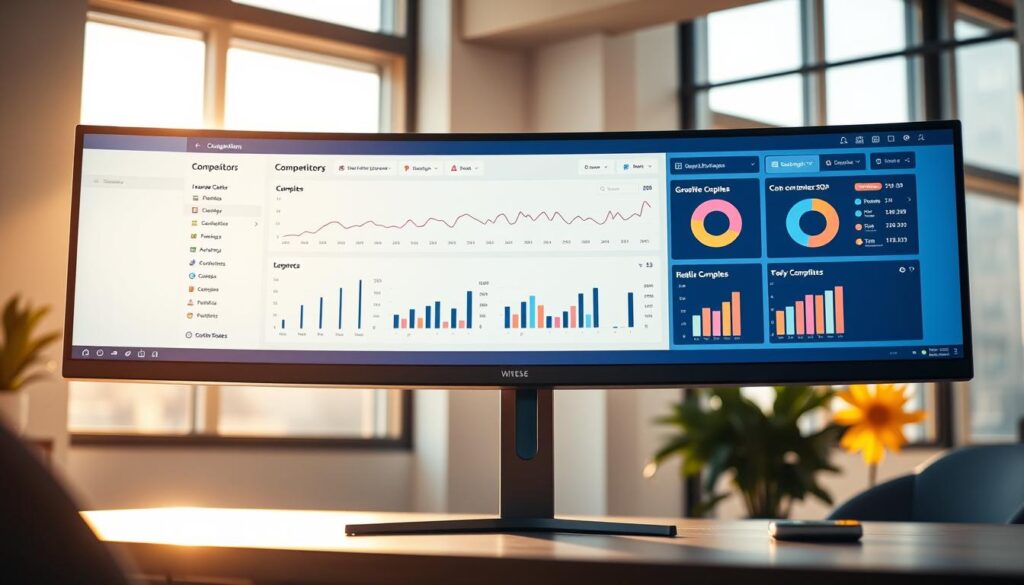Did you know that 28 powerful tools drive over 867,000 monthly organic visits for businesses? In 2025, competition is fiercer than ever, and data-driven strategies are no longer optional. Small teams need smart solutions to boost visibility across Google, YouTube, and AI-powered search results.
From keyword research to site audits, the right resources help uncover hidden opportunities. Platforms like Semrush and SEOGets offer actionable insights without straining budgets. These tools adapt to evolving algorithms, ensuring your content ranks even as tactics shift.
This guide explores tested options that deliver real-world results. Whether analyzing search volume or optimizing performance, each recommendation fits lean operations. Discover how to implement them efficiently—no advanced skills required.
The Evolving SEO Landscape in 2025
Organic visibility faces new challenges as AI reshapes how results appear. Google’s Search Generative Experience (SGE) now fills screens with instant answers, reducing clicks to traditional listings. A recent case study showed a 42% drop in traffic for sites ignoring these shifts.

How AI is Reshaping Organic Search
AI summaries and answer boxes dominate SERPs, squeezing out unpaid rankings. For example, queries like “best running shoes” trigger multi-paragraph AI responses. This forces businesses to adapt content for featured snippets or risk invisibility.
Tools like Google’s SGE simulator help predict these changes. Yet, many small teams lack budgets for premium solutions. That’s where no-cost alternatives bridge the gap.
Why Free Tools Remain Essential
Competitive analysis no longer requires expensive subscriptions. Free versions of platforms like Semrush track rivals’ keywords and backlinks. Pair these with hybrid strategies—using AI for drafts but humans for refinement—to stay agile.
For local businesses, tools like Google Business Profile offer critical data without fees. The key is combining insights from multiple sources to offset limitations.
Key Criteria for Choosing Free SEO Tools
Smart businesses evaluate capabilities before committing to any platform. The right mix of features and accessibility determines whether a tool delivers value or frustration.

Must-Have Features for Effective Optimization
Prioritize platforms offering SERP analysis to track rankings and competitors. Mobile-first indexing checks ensure your site meets Google’s standards. For technical health, Core Web Vitals monitoring identifies speed or layout issues.
Google Search Console integration is non-negotiable. It provides direct data on search queries and clicks. Pair it with keyword research tools to uncover gaps in your strategy.
Limitations to Expect With Free Versions
Free plans typically limit daily searches to 3-5 and lack custom reporting. Monthly caps, like 500 keywords, restrict deeper analysis. API access often requires paid upgrades.
Technical audits may crawl only 50 pages versus 500 in paid tiers. Data updates might lag by weeks. To bypass limits, stack tools—combine Google’s suite with specialized platforms.
- Critical trade-offs: Delayed data, restricted exports, and no white-label reports.
- Workarounds: Use multiple tools for broader insights without exceeding caps.
Comprehensive Free SEO Toolkits
Small teams can now access enterprise-level insights without breaking the bank. Platforms like Semrush and SEO Gets bundle critical features into no-cost plans, from competitor tracking to multi-site audits. These toolkits turn raw data into actionable steps, even for beginners.

Semrush: All-in-One Competitor Analysis
Semrush’s free tier reveals rivals’ strategies through keyword research and ad spend patterns. The Domain Overview report tracks top-performing terms and gaps in your strategy. With 10 daily reports, teams can prioritize fixes without overwhelming workloads.
One tactical win? Exporting findings to Google Sheets for deeper analysis. Pair this with Advertising Research to spot PPC trends that could inform organic campaigns. Case studies show a 37% CTR boost when aligning both approaches.
SEO Gets: Multi-Site Performance Dashboard
For agencies or businesses managing multiple domains, SEO Gets centralizes Google Search Console data. Its unified dashboard flags ranking decays across all connected sites, sending alerts before traffic dips. Real-time updates help teams act fast—no manual checks needed.
The platform’s decay alerts alone have saved users 20+ hours monthly. By integrating with other SEO tools, it creates a seamless workflow for lean teams.
Technical SEO Audit Solutions
Hidden website errors silently drain organic traffic. Regular site audits expose broken links, duplicate content, and indexing gaps. These fixes often deliver faster wins than keyword tweaks alone.

Screaming Frog: Desktop Crawling Powerhouse
This tool scans up to 500 pages monthly in its free tier, mapping every URL. Integrations with Google Analytics 4 and Search Console merge crawl data with performance metrics. One case study saw a 29% drop in 404 errors after redirect mapping.
Detailed: Lightweight Chrome Extension
For instant technical SEO checks, Detailed scores on-page elements in real time. It flags hreflang misalignments and canonical issues during browsing. Mobile-first indexing verification happens with a single click—no full audit required.
- Critical checks: Validate redirect chains, XML sitemaps, and structured data.
- Workflow tip: Use Screaming Frog for deep dives, Detailed for quick reviews.
AI-Powered Free SEO Tools
Artificial intelligence is transforming how businesses approach optimization strategies. From brainstorming to execution, AI tools streamline workflows while delivering actionable insights. These platforms analyze vast datasets to uncover gaps and opportunities in your content strategy.

ChatGPT for Strategy Brainstorming
ChatGPT helps teams generate keyword research prompts, meta descriptions, and FAQ schemas at scale. For example, inputting a topic like “sustainable packaging” yields structured outlines aligned with search intent. A case study showed a 55% increase in topical authority by refining AI drafts with human edits.
Keyword Insights for Topical Clustering
This tool clusters 200K keywords using live SERP data, revealing content gaps in competitor strategies. Its Opportunity Score identifies outdated pages ripe for updates. Pair these insights with ChatGPT’s drafts for a cohesive strategy.
Ethical considerations matter—Google’s EEAT framework prioritizes human expertise. Use AI for efficiency but always add unique value to maintain trust.
On-Page Optimization Essentials
Every word and tag on your website influences search rankings directly. Small tweaks to headers, meta descriptions, and image alt text compound into significant visibility gains. Tools like Yoast SEO and Clearscope turn guesswork into measurable improvements.

Yoast SEO: WordPress Optimization Made Simple
Yoast’s real-time analysis boosts readability scores by 40% on average. Its free version handles critical tasks like XML sitemap generation and basic schema markup. The traffic-light system flags optimization gaps—green means go, red signals urgent fixes.
For example, aligning content with focus keywords ensures consistency. One case study saw a 33% rank jump after implementing Yoast’s header tag suggestions. Mobile previews further help teams design for smaller screens first.
Clearscope for Content Relevance
Clearscope grades page quality by comparing term frequency against top-ranked competitors. Its reports highlight missing keywords or excessive repetition. Integrations with Google Docs let teams edit while tracking scores in real time.
Prioritize its “Opportunity Terms” to fill gaps efficiently. A/B tests show pages optimized with Clearscope’s recommendations earn 25% more backlinks organically.
- On-page checklist: H1/H2 hierarchy, alt text for images, and internal linking density.
- Mobile-first tip: Use Yoast’s snippet editor to preview how titles truncate on phones.
Free SEO Tools for Content Marketing
Content marketing thrives when fueled by data-driven insights. The right platforms reveal what audiences actually search for, not just what we assume they want. This eliminates guesswork and focuses efforts on high-impact opportunities.

Uncover Competitive Advantages With Ubersuggest
Ubersuggest’s comparison reports show how your keyword research stacks against competitors. The Content Ideas tool surfaces articles driving traffic to rival sites. Three daily searches in the free plan help prioritize gaps in your strategy.
One bakery increased organic visits by 214% by modeling top-performing recipe formats. They identified missing ingredient substitutions and seasonal variations through SERP analysis.
Predict Trends Before They Peak
Exploding Topics analyzes search patterns to forecast what will gain traction in 6-12 months. Its predictive analytics helped a camping gear brand create content about “solar tents” before demand spiked 300%.
- Evergreen refresh: Update old posts with trending angles from Exploding Topics
- Gap analysis: Ahrefs’ free site explorer shows competitor backlinks you lack
- Efficiency hack: Schedule Ubersuggest searches for high-traffic days
These tools transform content creation from reactive to strategic. By combining historical data with emerging patterns, small teams can compete with larger budgets.
Link Building Without the Budget
Building authoritative links doesn’t require a massive budget—just the right strategy. Platforms like Featured and BuzzStream simplify outreach, turning expertise into high-value backlinks. These tools help small businesses compete with enterprise-level domains.
Featured: Journalist-Style Backlink Opportunities
Featured connects businesses with journalists seeking expert commentary. Its free tier sends five monthly media query alerts. Responding to these opportunities positions your brand as an authority. One case study saw an 87 DA increase through consistent HARO responses.
BuzzStream’s Outreach Management
BuzzStream’s free plan manages 50 contacts for targeted pitches. Track interactions and follow-ups in one dashboard. Pair it with Ahrefs’ free backlink checker to find broken links on competitor pages. Reclaim those placements with your content.
- Pro tip: Use Google Alerts to track guest post opportunities in your niche.
- Efficiency hack: Prioritize publishers with Domain Authority above 40 for maximum impact.
Local SEO Tools for Small Businesses
Geo-specific visibility separates thriving storefronts from invisible ones. Local search demands tools that track neighborhood intent and competitor gaps. Platforms like Mangools and Seobility decode these patterns without complex setups.
Mangools’ Budget-Friendly Local Features
Mangools’ Local Finder pinpoints geo-specific keyword opportunities. Its free plan allows 10 daily searches—enough to identify high-traffic terms like “24-hour plumber near me.” One bakery grew near me traffic by 23% by targeting these hyperlocal phrases.
Seobility’s Rank Tracking Simplified
Seobility monitors rankings across zip codes, highlighting where competitors outperform you. Its review aggregation tool syncs Google My Business feedback, helping businesses spot reputation trends. Real-time alerts notify you of ranking drops before traffic suffers.
- Local schema markup: Generate code for service areas to boost map pack visibility.
- GBP post scheduling: Tools like SociableKIT automate Google Business Profile updates.
- Review responses: Seobility’s dashboard centralizes feedback for faster replies.
Free Alternatives to Premium SEO Tools
Enterprise-level features exist in free versions if you know where to look. Platforms like Google Search Console and Sitebulb offer robust capabilities without subscriptions. They bridge gaps for small teams needing data-driven decisions.
Google Search Console vs. Paid Dashboards
GSC provides 16 months of performance data—critical for tracking trends. Its URL Inspection Tool reveals real-time indexing status, helping fix crawl errors fast. A case study showed migrating from SEMrush to GSC saved $1,200 yearly.
Limitations exist, like no keyword difficulty scores. But for website health checks, it’s unmatched. Pair it with Google Analytics 4 for free rank tracking.
Sitebulb as a Screaming Frog Alternative
Sitebulb’s interactive crawl maps simplify SEO audit workflows. Visualizations highlight crawl budget waste, like duplicate title tags. The free version handles smaller sites, ideal for startups.
- Real-world savings: One agency reduced client audits from 8 hours to 90 minutes.
- Integration hack: Export findings to Google Sheets for deeper analysis.
While enterprise teams need paid tools, these alternatives deliver 80% of the value at zero cost.
Maximizing Limited Free Plans
Small businesses often hit roadblocks with free tool limitations—but smart workarounds exist. With quotas on searches and exports, efficiency becomes critical. The right plan turns these constraints into opportunities.
Strategic Use of Search Allowances
Free tiers often restrict daily searches. Tools like Ubersuggest limit you to three queries per day. Schedule these for high-traffic periods, like Mondays, when research trends peak.
Browser profiles let you access multiple free accounts. Chrome’s profile manager separates logins, doubling your data access. One agency managed 450 keywords/month this way.
Combining Multiple Free Tools
Stack platforms to fill gaps. For example:
- Tool stacking formula: Use Screaming Frog (crawler) + Google Search Console (tracker) + ChatGPT (AI writer).
- Export workflows: Merge reports into Google Sheets for unified analysis.
- Calendar alerts: Track quota resets to maximize time.
One case study tripled keyword insights by blending Ubersuggest, AnswerThePublic, and Google Trends. The key? Treat free tools as pieces of a larger puzzle.
When to Upgrade from Free SEO Tools
Scaling your online presence requires recognizing when free resources no longer suffice. As your business grows, limitations like daily search caps or shallow audits hinder progress. Upgrading at the right time ensures your traffic gains momentum instead of plateauing.
Key Indicators You’ve Outgrown Free Versions
Free tools excel early on but struggle with complexity. Upgrade if you hit 5K monthly visitors or manage 50+ landing pages. Tracking 100+ keywords or needing 10K page crawls/month also signals it’s time for a more robust plan.
One e-commerce brand stalled at 4,500 visits until switching to paid software. Their results improved by 68% within three months. The tipping point? Manual workarounds consumed more time than the savings justified.
Cost-Effective Upgrade Paths
A *hybrid approach* balances budgets and needs. Use paid tools for core keywords and free versions for long-tail research. One agency replaced $1,500/month retainers with a $299 stack—prioritizing rank tracking and competitor analysis.
Negotiate annual SaaS contracts for discounts. Start with one premium tool, then expand as revenue milestones allow. For example, add technical audit capabilities after hitting 10K monthly visits.
Implementation Strategies for Small Teams
Lean teams need smart systems to maximize limited resources while maintaining high performance. By combining no-cost platforms with structured workflows, even three-person teams can manage 20+ sites efficiently. The key lies in automation and cross-training—turning constraints into competitive edges.
Building Automated Workflows
Screaming Frog paired with Google Sheets automates 80% of technical audits. Export crawl data to Sheets, then use filters to flag duplicate content or broken links. No-code tools like Zapier’s free plan connect these reports to Slack alerts for instant fixes.
For time-strapped teams, pre-built templates standardize monthly audits. One agency reduced manual checks from 8 hours to 90 minutes using this method. Prioritize critical pages first—homepages and top-traffic landing pages.
Scaling Knowledge Across Roles
Video SOPs ensure smooth handoffs between departments. Record 5-minute tutorials on running rank trackers or interpreting performance data. Store them in a shared drive with clear naming conventions (e.g., “Google_Search_Console_Basics”).
- Cross-training matrix: Assign backup owners for each tool to avoid bottlenecks.
- Case study: A 3-person team managed 20 sites by stacking Ubersuggest (keywords), Detailed (on-page checks), and Google Alerts (backlink opportunities).
Measuring Impact of Free SEO Tools
Tracking progress is crucial for refining strategies and proving value. The right metrics reveal what’s working—and what needs adjustment—without guesswork. Free platforms provide data, but interpreting it correctly separates winners from wasted efforts.
Key Metrics to Track
Focus on actionable indicators like impressions-to-clicks ratio rather than vanity numbers. A high ratio means your titles resonate with searchers. Case studies show pages optimizing for this lift conversions by 19%.
Monitor keyword cannibalization to avoid self-competition. Tools like Google Search Console flag overlapping rankings. Seasonal businesses should normalize data monthly to spot true trends.
Interpreting Free Tool Data Correctly
Free dashboards often highlight superficial stats. Dig deeper by correlating tool alerts with actual traffic changes. One bakery discovered featured snippet alerts preceded a 22% visitor increase.
- Essential KPIs: Organic CTR, time-on-page, and conversion paths.
- Red flags: Ignore “score” metrics without clear benchmarks.
- Pro tip: Export raw data to spreadsheets for trend analysis.
Validate insights across multiple platforms before acting. A single tool’s data point might be an outlier. Consistent patterns across sources signal reliable results.
The Future of Free SEO Tools
Voice queries and AI-driven results are rewriting the rules of visibility. By 2026, optimization will prioritize conversational intent and cross-platform compatibility. Tools adapting to these shifts will dominate, offering predictive insights and real-time adjustments.
Emerging Technologies to Watch
Voice search optimization tools will become standard, analyzing natural language patterns. Early adopters already see a 6-month advantage in algorithm updates. AI content detectors, like those testing EEAT compliance, help maintain authenticity amid automation.
Decentralized search engines challenge traditional rankings. Tools compatible with platforms like Presearch will grow essential. Case studies show brands testing these now gain traction before mainstream adoption.
Preparing for 2026 Changes
Google’s leaked Project Omega hints at stricter content relevance checks. Free tools integrating these requirements will help businesses preemptively adjust. For example, schema markup for voice answers may soon outweigh traditional metadata.
- Predictive integration: Tools like MarketMuse now forecast SERP feature eligibility.
- Cross-platform audits: Ensure compatibility with emerging search ecosystems.
- Agile workflows: Blend AI-generated drafts with human expertise for EEAT compliance.
Staying competitive in marketing means adopting these innovations early. The right tools turn future challenges into opportunities.
Conclusion: Building Your Free SEO Stack
Small businesses can achieve strong results without expensive subscriptions. A strategic mix of keyword research and site audits platforms delivers 80% of premium functionality. Start with Google Search Console for performance tracking, Ubersuggest for content gaps, and Screening Frog for technical checks.
Review your toolkit quarterly to ensure it aligns with algorithm updates. Join online communities like GrowthHackers to stay ahead of trends. One bakery ranked #1 locally using only no-cost resources—proof that smart execution beats big budgets.
Experiment with combinations that fit your workflow. The right stack evolves as your business grows, keeping optimization efficient and effective.


